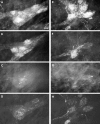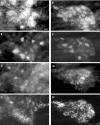Serum from achalasia patients alters neurochemical coding in the myenteric plexus and nitric oxide mediated motor response in normal human fundus
- PMID: 16105888
- PMCID: PMC1856095
- DOI: 10.1136/gut.2005.070011
Serum from achalasia patients alters neurochemical coding in the myenteric plexus and nitric oxide mediated motor response in normal human fundus
Abstract
Background and aims: Achalasia is a disease of unknown aetiology. An immune mechanism has been suggested on the basis of previous morphological observations. The objective of this study was to test whether the serum of achalasia patients could reproduce the phenotype and functional changes that occur with disease progression in an ex vivo human model.
Methods: Specimens of normal human fundus were maintained in culture in the presence of serum from patients with achalasia, gastro-oesophageal reflux disease (GORD), or healthy subjects (controls). Immunohistochemical detection of choline acetyltransferase (ChAT), neurone specific enolase (NSE), vasoactive intestinal polypeptide (VIP), nitric oxide synthase (NOS), and substance P was carried out in whole mounts of gastric fundus myenteric plexus. In addition, the effects of achalasia serum on electrical field stimulation (EFS) induced contractions were measured in circular muscle preparations.
Results: Serum from achalasia patients did not affect the number of myenteric neurones. Tissues incubated with serum from achalasia patients showed a decrease in the proportion of NOS (-26% of NSE positive neurones; p=0.016) and VIP (-54%; p=0.09) neurones, and a concomitant increase in ChAT neurones (+16%; p<0.001) compared with controls. In contrast, GORD serum did not modify the phenotype of myenteric neurones. Area under the curve of EFS induced relaxations (abolished by N-nitro-L-arginine methyl ester) was significantly decreased following incubation with serum from achalasia patients compared with controls (-7.6 (2.6) v -14.5 (5.0); p=0.036).
Conclusions: Serum from achalasia patients can induce phenotypic and functional changes which reproduce the characteristics of the disease. Further identification of putative seric factors and mechanisms involved could lead to the development of novel diagnostic and/or therapeutic strategies in achalasia.
Conflict of interest statement
Conflict of interest: None declared.
Comment in
-
Novel mechanism for impaired nitrergic relaxation in achalasia.Gut. 2006 Mar;55(3):304-5. doi: 10.1136/gut.2005.078402. Gut. 2006. PMID: 16474101 Free PMC article.
References
-
- Sifrim D, Janssens J, Vantrappen G. Failing deglutitive inhibition in primary oesophageal motility disorders. Gastroenterology 1994106875–882. - PubMed
MeSH terms
Substances
LinkOut - more resources
Full Text Sources








